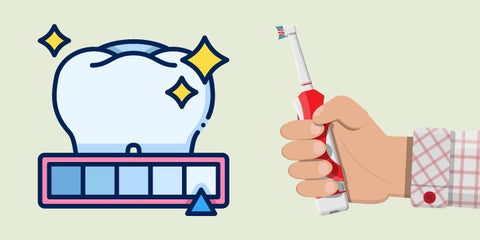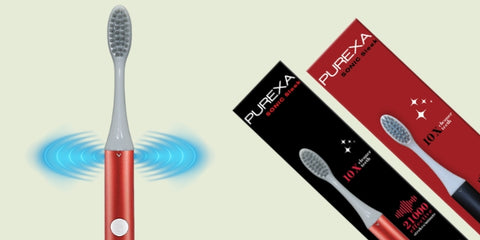The debate between electric and manual toothbrushes is not settling down anytime soon. Dentists and researchers everywhere are working towards educating people on the uses, features, and advantages of each, thereby helping them make the right choice for their unique case.
As the dialogue resurfaces and opinions run loose, brushing up on the age-old comparison is necessary.
Table of Contents
Manual vs Electric Toothbrushes
|
POINT OF COMPARISON |
MANUAL TOOTHBRUSHES |
ELECTRIC TOOTHBRUSHES |
|
Working |
Manual toothbrushes rely on hand movements to clean the teeth. The better the technique, the cleaner your teeth. |
Electric toothbrushes come with a rotating or oscillating head that plucks the bacteria out of the smallest chinks. |
|
Efficiency against plaque and dental stains |
Manual toothbrushes are by comparison less effective for cleaning plaque and stains. |
Multiple research studies have proven electric toothbrushes remove plaque and stains better than their manual counterparts. |
|
Customisability |
Manual toothbrushes lack the customisability feature. |
Electric toothbrushes have different settings and modes, so you can tailor the brushing experience to meet your individual needs. |
|
Price point |
Manual toothbrushes are a breeze to your pockets. But maintenance charges can be high. And it needs to be discarded as a whole once the bristles have run their course. |
Electric toothbrushes are priced higher but prove to be economical in the long run. They come with a long battery life and it's only the head that needs to be replaced. |
|
Built-in timers |
You have to physically keep track of the time you spend brushing your teeth. |
Electric toothbrushes come with built-in-timers to make sure you brush your teeth for the exact 2 minutes as recommended by dentists. |
The old ball and chain can be an easy choice to make. But weighing the features of both the products neck-to-neck, including the electric toothbrush benefits will help you make an informed decision.
How to use an electric toothbrush?

So your bathroom vanity is all arranged to make space for another homie. Your electric toothbrush is out of the case and waiting for introductions to be made. With nervousness and excitement out of the way, it's time you bring the newcomer into play.
Here’s a step-by-step manual on how to put your toothbrush to work.
- Electric toothbrushes are usually partly charged by the company. So they can be used before giving another recharge. However, you’re free to juice it 100% if that's how you roll.
- Most people prefer flossing before brushing to stray out any food particles sitting in between their teeth.
- Getting to the execution part, wet the toothbrush and apply the toothpaste to the bristles.
- When starting to brush, angle the brush at 45 degrees, similar to a manual toothbrush. Move the brush head slowly across outer tooth surfaces, pausing briefly on each tooth. Maintain the shape of each tooth and follow the curve of your gums.
- After cleaning the outer surfaces, repeat the process on inner and chewing surfaces, including behind the back teeth. When done, focus on the gum line and gums, but avoid pressing too hard to prevent irritation.
- After brushing, rinse the toothbrush head and store it upright to air dry. Avoid covering the brush head to prevent bacterial growth.
To optimise the effectiveness of your electric toothbrush, take advantage of its built-in timer, typically set for two minutes, to ensure thorough brushing. Some models also signal every thirty seconds to prompt moving to the next mouth section, which should be divided into four parts:
- Front teeth
- Back teeth
- Chewing surfaces and areas behind back teeth
- Tongue and roof of the mouth
Avoid applying excessive pressure or scrubbing while using the electric toothbrush. Instead, gently guide the brush along as it cleans. Certain models feature pressure sensors to alert you if too much force is applied.
Ideally, the electric toothbrush should clean one tooth at a time, adjusted according to tooth and brush head size.
Now that we are through the manual, let’s set sail to explore the PUREXA electric toothbrush.
PUREXA Electric Toothbrush

With high-frequency sonic vibrations, class-defining colour options, and a sleek design accentuating its functions, PUREXA smart electric toothbrush lays out the welcome mat for your oral health.
It promises up to 21,000 strokes per minute, ensuring 5x more effective plaque removal compared to manual toothbrushes.
Sound sonic technology powers the sophisticated build to reach the far-off turf.
Powered by a single AAA battery, PUREXA electric toothbrushes are engineered to last up to 180 days.
Our Battery toothbrush comes with a 2-minute timer with quad reminder technology to make sure that you don't fall short of the recommended cleaning time.
With an IPX7 waterproof rating and 5 heart eyes for durability, our collection is designed for both adults and kids, keeping in mind their varied needs.
Visit our website to learn more about our products.
Closing Thoughts
Our busy schedules leave very little time for us to squeeze in regular dental appointments. With diets sliding off the slope and the risk of dental problems increasing among kids and adults alike, it’s important to take the right steps to keep your oral health in check.
Knocking off manual toothbrushes with electrics, using proper solutions to rinse your mouth, and choosing a case-sensitive toothpaste are some basic practices to keep yourself out of trouble. Precaution, when not taken at the right time, leads to a predicament. Don’t let diseases come for your teeth or bacteria seek shelter in your mouth, Use the right products and adopt wise practices to steer clear of the thorny road of dental ailments.
Written by Dr. Shipra Jaiswal, BDS, MDS, a Periodontist and Gums Specialist